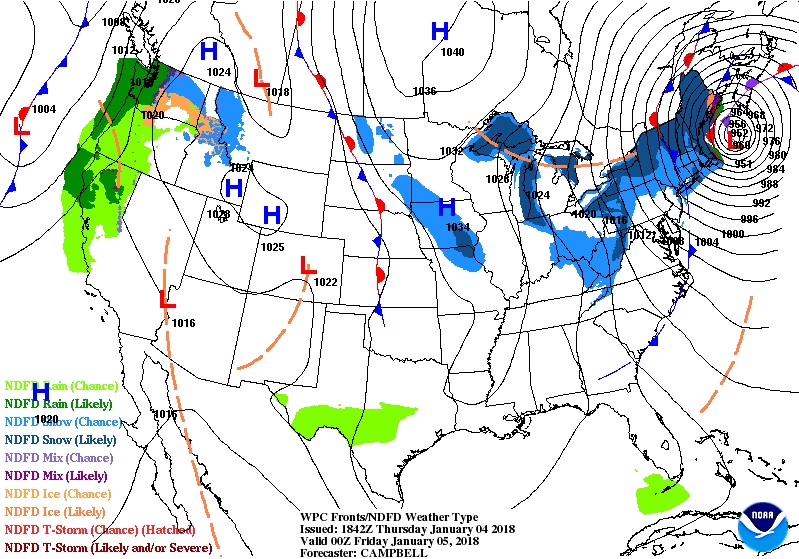Bombogenesis, the phenomenon behind North America's winter storm

The U.S. National Oceanic and Atmospheric Administration (NOAA) has issued an informative summary of 'bombogenesis', a weather phenomenon that has generated a big winter storm but is "not as scary as it sounds".
In its update, the NOAA said bombogenesis - also known as a bomb cyclone - occurred when a storm rapidly intensified over a 24-hour period. 
"More precisely, it’s a mid-latitude cyclone that rapidly intensifies, with a central pressure that drops at least 24 millibars over 24 hours. (A millibar measures atmospheric pressure.)," the administration said.
"This is exactly what NOAA’s National Weather Service expects with this system between Wednesday, January 3, and Friday, January 5."
"The term is a meteorological one and doesn’t describe the impacts of the weather system, which often include high winds, heavy precipitation and even storm surge. Stay informed and stay safe by keeping track of NOAA’s Weather Prediction Center’s latest discussion on this winter storm and checking your local forecast at weather.gov."
In an update, the NOAA forecast heavy snow would continue overnight in the U.S. Northeast but wane on Friday morning.
"Meanwhile, in the wake of the storm, an area of cold high pressure will move southward out of Central Canada into the Upper Mississippi Valley on Thursday into Friday," the administration said.
"The cold air and upper-level energy will move over the Lakes producing lake effect snow downwind from the Great Lakes through Saturday. The snow may be heavy at times.
"In addition, upper-level jet dynamics will aid in producing a streak of light snow over parts of the Northern Plains/Upper Mississippi Valley, on Thursday, that will move to parts of the Western Ohio Valley before dissipating on Friday morning."
The NOAA added a front would move into the Pacific Northwest from Thursday into Saturday.
"Moisture will also move into the West Coast through Saturday, too. Rain will develop over parts of the Pacific Northwest Coast into Northern/Central California on Thursday that will expand into interior parts of the Northwest on Thursday evening into Friday evening," the administration said.
"Some of the interior valleys of the Northwest/Northern Intermountain Region will develop areas of rain/freezing rain on Thursday evening into Friday evening as well."
In terms of fruit crops, the Associated Press reported strawberry and citrus growers were using irrigation systems to protect fruit in Florida.
Texas Citrus Mutual president Dale Murden told Fresh Fruit Portal no citrus damage was expected in his state, with a low of 27°F in some very low areas and some incidents of frost.
"Tender veggies and pasture grass may have some damage," Murden added added as a side note.
Have your crops, logistics or fresh produce trading been affected by the storm? Be sure to let us know at news@freshfruitportal.com or on social media (Twitter: @fruitportal, Facebook: @FreshFruitPortal)
USDA offers food safety tips for affected areas
The United States Department of Agriculture (USDA) has also issued some food safety advice for those impacted, urging people not to leave perishable food in the snow.
"Outside temperatures can vary and food can be exposed to unsanitary conditions and animals. Instead, make ice by filling buckets or cans with water and leave them outside to freeze. Use this ice to help keep food cold in the freezer, refrigerator or coolers," the department said.
The USDA also recommended taking the following steps in advance in case you lose power:
- Keep appliance thermometers in both the refrigerator and the freezer to ensure temperatures remain food safe during a power outage. Safe temperatures are 40°F or lower in the refrigerator, 0°F or lower in the freezer.
- Freeze water in one-quart plastic storage bags or small containers prior to a storm. These containers are small enough to fit around the food in the refrigerator and freezer to help keep food cold. Remember, water expands when it freezes, so don’t overfill the containers.
- Freeze refrigerated items, such as leftovers, milk and fresh meat and poultry that you may not need immediately—this helps keep them at a safe temperature longer.
- Know where you can get dry ice or block ice.
- Have coolers on hand to keep refrigerator food cold if the power will be out for more than four hours.
- Group foods together in the freezer—this ‘igloo’ effect helps the food stay cold longer.
- Keep a few days’ worth of ready-to-eat foods that do not require cooking or cooling.
Headline photo: iStock


















































